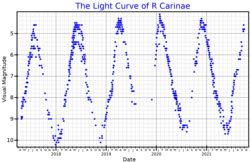Top Qs
Timeline
Chat
Perspective
R Carinae
Variable star in the constellation Carina From Wikipedia, the free encyclopedia
Remove ads
R Carinae is a double star in the southern constellation of Carina. The brighter component is a variable star that can be viewed with the naked eye at peak brightness,[11] but is usually too faint to be seen without a telescope, having an apparent visual magnitude that fluctuates around 7.43.[6] This star is located at a distance of approximately 600 light years from the Sun based on parallax,[2] and is drifting further away with a radial velocity of +28 km/s.[6]
Benjamin Apthorp Gould discovered the variable star, in 1871. It appeared with its variable star designation in Annie Jump Cannon's 1907 work, Second Catalogue of Variable Stars.[12] The main component is an aging red giant star on the asymptotic giant branch[4] with a stellar classification of M6/7pe.[5] It is classified as a pulsating Mira type variable star and its visual brightness varies with an average amplitude of 4.25 magnitudes over a period of 303.99±1.08 d. Its average maximum visual magnitude is 5.05±0.45,[11] but the brightest observed maximum was magnitude 3.9.[3] The pulsations make its size change, in 2014, it was 400 times larger than the Sun, while in 2020 it was 540 times larger.[7] This star is surrounded by a dusty shell, with properties that are consistent with iron-poor silicates or corundum, extending from around three stellar radii outward.[13]
The companion is a magnitude 11.30 star at an angular separation of 2.10″ along a position angle of 132° from the main star, as of 2015.[14]
Remove ads
References
Wikiwand - on
Seamless Wikipedia browsing. On steroids.
Remove ads

